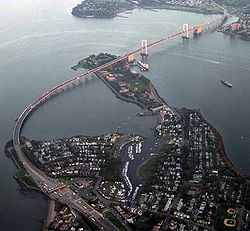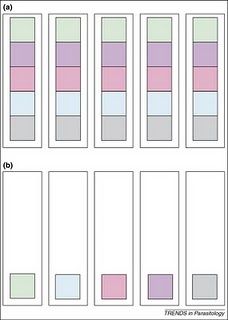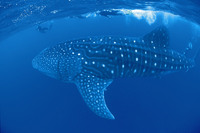Tilting the three-way tango - disease as a loss of diversity
 Wednesday, April 28, 2010 at 9:00AM
Wednesday, April 28, 2010 at 9:00AM ![]() Disease is a funny old thing. We're taught from very early on that disease agents are "bad" and that, by contrast, the infected are somehow poor and unfortunate victims of nasty evil bugs. This is clearly a cultural bias, wherein we project our own concerns about getting sick onto all other animals; there's no real reason to think that a bacterium or virus has any less right to be here or any less important role in the ecological processes of the world than does the dolphin it infects, or the fish or the lobster. We have all survived eons while avoiding extinction, which makes us winners in the great game of evolution, the microbes every bit as much (or more) than their hosts.
Disease is a funny old thing. We're taught from very early on that disease agents are "bad" and that, by contrast, the infected are somehow poor and unfortunate victims of nasty evil bugs. This is clearly a cultural bias, wherein we project our own concerns about getting sick onto all other animals; there's no real reason to think that a bacterium or virus has any less right to be here or any less important role in the ecological processes of the world than does the dolphin it infects, or the fish or the lobster. We have all survived eons while avoiding extinction, which makes us winners in the great game of evolution, the microbes every bit as much (or more) than their hosts.
These days, disease studies are becoming a lot more nuanced, and its revealing a whole new world of how diseases start and stop. Rocco Cipriano, a microbiologist colleague of mine at the National Fish Health Labs in Leetown WV, has been promoting a model lately where an infectious disease of fish (furunculosis) is caused by a disruption to the natural community of bacteria on the skin of fish; a community in which pathogens have no place normally. The furunculosis agent (Aeromonas) is excluded from these communities by bacteria better adapted to living in normal fish skin and its associated mucus layer. That is, until an environmental modulator, like a temperature spike or pollutant, shakes things up a bit; what ecologists would call disturbance. And what is the first outcome of disturbance in most systems? Loss of diversity, in this case among the normal bacterial community. Some bacteria disappear from the skin of the fish, freeing up resources (space, food) that are exploited by other bacteria - opportunists that can come in and pounce on the new space or food. When that space and food consists of the fish itself, we call those bacteria pathogens. This same process happens after any ecological disturbance, like a hurricane on a reef or a tree falling in a rainforest: opportunists come in and pounce on a newly-available resource; then as things settle down a succession takes place, until the early colonisers are displaced by more typical fauna. In this view, disease is nothing more than a byproduct of disturbance and loss of diversity in the normal microbial community.
Which brings me back to corals and to the recent paper by Mao-Jones and colleagues in PLoS Biology. These folks used a mathematical model to show that much the same holds true for the diseases of corals, which, like fish, rely heavily on a surface layer of mucus as their first line of defence. It seems that in both corals and fish, the mucus is important, but even more important are the normal bacteria that live there, continually excluding pathogens and acting as a protective guard against disease. In a very anthropomorphic sense, the corals (and fish) are using the surface bacteria as a biological weapon against the potential pathogens, at the expense of having to produce all that mucus for the bacteria to live and feed on. Importantly, Mao-Jones and friends show us that the derangement of the mucus community can persist for a really long time after the initial disturbance. This is important, because you often come along and see disease starting, but you may well have missed the initial insult that got the ball rolling, which may have occurred some time ago.
I really like this idea of infectious disease as an ecological disturbance and of many pathogens as simply early colonisers in the succession back towards health (or towards death, if the disturbance was too severe). As a model, it doesn't work for everything, though. There are many "primary pathogens" that are specifically adapted to invade healthy animals, but its not in the best interests of those organisms to invest so much energy in adaptations to invasion, only to kill the host, thus many of those are fairly benign. For more "opportunistic" agents, however, I suspect it holds true much of the time, and that group includes many or most of the really virulent diseases. I dare say many of the "emerging" diseases fall in this category, and we can expect to see more of this as the global climate continues to tilt the tango in favour of the pathogens.
Mao-Jones, J., Ritchie, K., Jones, L., & Ellner, S. (2010). How Microbial Community Composition Regulates Coral Disease Development PLoS Biology, 8 (3) DOI: 10.1371/journal.pbio.1000345
 Post a Comment |
Post a Comment |  Email Article | tagged
Email Article | tagged  GCC,
GCC,  coral reef,
coral reef,  disease,
disease,  diversity,
diversity,  fish,
fish,  global warming,
global warming,  parasites
parasites 












